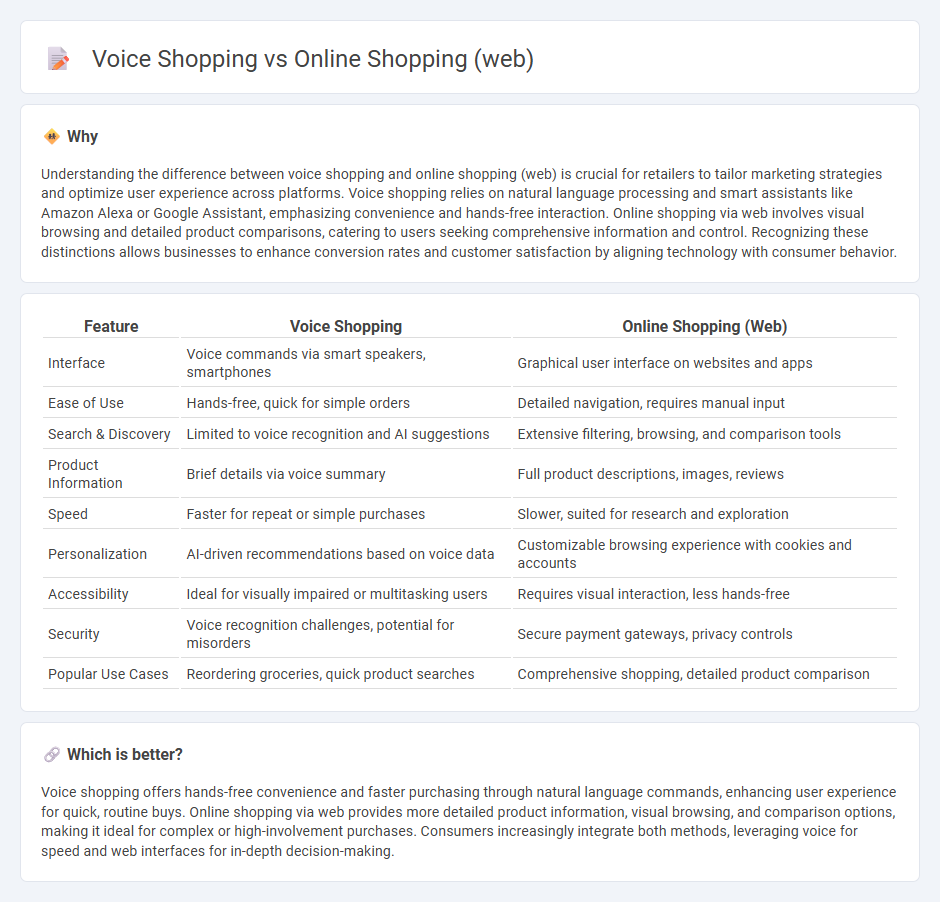
Voice shopping leverages smart speakers and voice assistants like Alexa and Google Assistant to enable hands-free purchasing through natural language commands. Online shopping via websites offers detailed product information, visual browsing, and user reviews, facilitating a more traditional, interactive buying experience. Explore how these two retail innovations shape consumer behavior and shopping convenience.
Why it is important
Understanding the difference between voice shopping and online shopping (web) is crucial for retailers to tailor marketing strategies and optimize user experience across platforms. Voice shopping relies on natural language processing and smart assistants like Amazon Alexa or Google Assistant, emphasizing convenience and hands-free interaction. Online shopping via web involves visual browsing and detailed product comparisons, catering to users seeking comprehensive information and control. Recognizing these distinctions allows businesses to enhance conversion rates and customer satisfaction by aligning technology with consumer behavior.
Comparison Table
| Feature | Voice Shopping | Online Shopping (Web) |
|---|---|---|
| Interface | Voice commands via smart speakers, smartphones | Graphical user interface on websites and apps |
| Ease of Use | Hands-free, quick for simple orders | Detailed navigation, requires manual input |
| Search & Discovery | Limited to voice recognition and AI suggestions | Extensive filtering, browsing, and comparison tools |
| Product Information | Brief details via voice summary | Full product descriptions, images, reviews |
| Speed | Faster for repeat or simple purchases | Slower, suited for research and exploration |
| Personalization | AI-driven recommendations based on voice data | Customizable browsing experience with cookies and accounts |
| Accessibility | Ideal for visually impaired or multitasking users | Requires visual interaction, less hands-free |
| Security | Voice recognition challenges, potential for misorders | Secure payment gateways, privacy controls |
| Popular Use Cases | Reordering groceries, quick product searches | Comprehensive shopping, detailed product comparison |
Which is better?
Voice shopping offers hands-free convenience and faster purchasing through natural language commands, enhancing user experience for quick, routine buys. Online shopping via web provides more detailed product information, visual browsing, and comparison options, making it ideal for complex or high-involvement purchases. Consumers increasingly integrate both methods, leveraging voice for speed and web interfaces for in-depth decision-making.
Connection
Voice shopping integrates seamlessly with online shopping by enabling consumers to use voice commands to search, select, and purchase products through voice-activated devices directly linked to e-commerce websites. This connection enhances convenience and accessibility, driving higher conversion rates on retail platforms by reducing friction in the shopping process. Retailers optimize their online catalogs for voice search queries to ensure product discoverability and improve user experience.
Key Terms
User Interface (UI)
Online shopping interfaces rely heavily on visual elements like images, menus, and buttons, allowing users to browse and compare products efficiently. Voice shopping interfaces use natural language processing and speech recognition to create hands-free, conversational experiences, emphasizing ease of use and accessibility. Explore the strengths and challenges of each UI to understand how they shape consumer behavior and satisfaction.
Natural Language Processing (NLP)
Natural Language Processing (NLP) dramatically enhances the efficiency and user experience of voice shopping by enabling accurate interpretation of spoken commands and contextual understanding. In contrast, online shopping relies heavily on keyword-based search and visual navigation, which limits interaction richness and may hinder finding personalized results. Explore how advancements in NLP can bridge these gaps and revolutionize consumer engagement across both platforms.
Checkout Process
The checkout process in online shopping typically involves a series of manual steps such as cart review, entering payment and shipping details, and confirming the order on a visual interface. Voice shopping streamlines this with spoken commands and automated confirmation, reducing friction by eliminating the need for screen navigation and text input. Explore how these different approaches impact user convenience and conversion rates for a deeper understanding.
Source and External Links
Shopify: The All-in-One Commerce Platform for Businesses - Shopify offers a comprehensive ecommerce platform enabling businesses of all sizes to sell online, in person, locally and globally, with customizable stores and powerful sales tools, supporting millions of merchants and $1 trillion in sales.
Nordstrom Online & in Store: Shoes, Jewelry, Clothing, Makeup ... - Nordstrom provides an online shopping experience for a wide range of products including clothing, shoes, jewelry, and makeup, featuring free shipping and returns.
Target : Expect More. Pay Less. - Target's online shopping platform offers a broad assortment from groceries to electronics, with options such as contactless pickup, delivery, student and teacher discounts, and deals on household and beauty products.
 dowidth.com
dowidth.com